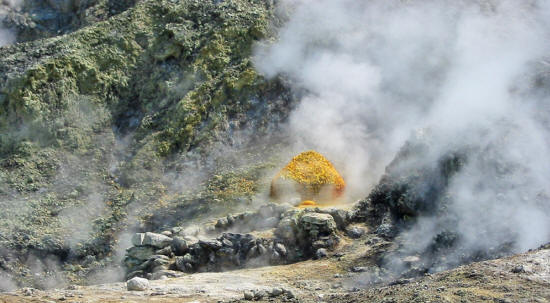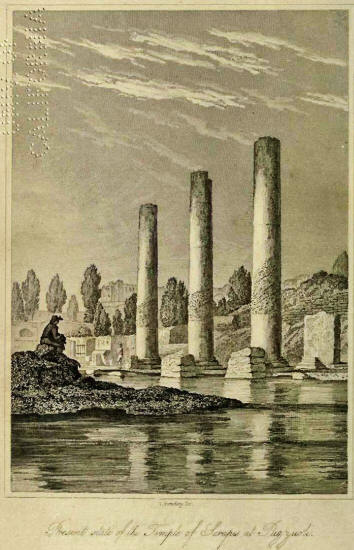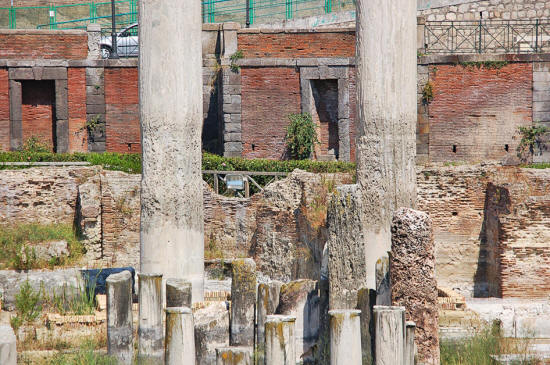|
Like the Yellowstone caldera in the United States, the Phlegraean Fields have previously demonstrated a capacity for titanic eruptions. In antiquity, the Romans believed that the god Vulcan lived inside the Solfatara crater within the Phlegraean Fields, and that the jets of steam and sulfurous gases that still emerge from the dormant volcano were driven by the workings of his forge.
There's even archaeological evidence suggesting that a Phlegraean eruption some 37,000 to 39,000 years ago was so massive, it may have killed large segments of the extant Neanderthal population, either directly or by causing a volcanic winter.
Now, the massive supervolcano is showing
signs of awakening. The Phlegraean Fields occupy a unique position in volcanology. In 1538, an eruption created Italy's Monte Nuovo, a 1,500-foot cinder cone volcano, over a period of just six days.
This was the first time the creation of a volcano was observed in the historical record. Many of the Italians living in the area at the time left detailed records of the multi-stage eruption sequence and the observed behavior of the volcano itself.
In the 18th century, King Charles of Naples conducted excavations in the nearby town of Pozzuoli and uncovered an unusual set of columns that (eventually) rewrote our understanding of geology.
A 19th century drawing of the pillars
The columns in question were part of the marcellum (marketplace) of the old Roman colony of Puteoli.
What made them unusual is the band of borings visible across all three columns. These borings are created by lithophaga, or date mussels, when they attach themselves to coral or rock outcroppings.
Since mussels live underwater, these borings were proof that the columns of Pozzuoli had spent an extensive period of time underwater. Historians and scientists in the 17th and 18th centuries were well aware that there were cities that existed in antiquity that now dwelt beneath the waves.
What they lacked was any understanding of the geologic processes that could drive these events, especially given that the marcellum columns had clearly been built above water, submerged to a depth of at least seven meters (based on the banding), and then re-emerged at a later date.
Today, we know that land can rise or fall as magma or water move into or out of a specific area.
This is known as bradyseism and it explains how the columns rose and fell so dramatically without toppling or sustaining damage. From 1968 to 1972, the Campi Flegrei area rose 1.7 meters, followed by a second 1.8 meter rise from 1982-1984.
From 2012-2013 the area rose an additional four inches, but this time scientists found evidence that the uplift was driven by magma shifts, specifically, rather than hydrothermal activity.
The critical concern of the researchers (Magmas Near the Critical Degassing Pressure Drive Volcanic Unrest towards a Critical State) is that the magma beneath the Phlegraean Fields may reach what they call Critical Degassing Pressure, or CDP. Deep within the Earth, molten rock is subject to tremendous pressure.
As it rises towards the surface, the decreased pressure allow volatile gases to begin separating from the molten stone itself. What this research suggests is that there is a tipping point at which reduced pressure injects huge amounts of steam into the surrounding rock strata.
From here, what happens is uncertain. In theory, releasing that much steam could cool the magma, stopping the eruption cold. Alternately, it could destabilize the rock, accelerating the deformation process and resulting in a full-scale eruption.
While the absolute risk is still relatively small, Campi Flegrei has been quite active in recent decades, in ways that suggest it could be preparing to erupt.
With half a million people living in Naples and the surrounding area, a sudden eruption could be catastrophic. While there's no evidence yet that the volcano is definitively preparing a Mt. Tambora-equivalent blast, a new volcanic winter could imperil millions of lives across the globe.
For the curious, the 1815 eruption of Mt. Tambora caused the Year Without A Summer in 1816.
Worldwide temperatures fell 0.4-0.7°C, while temperatures in Europe plunged by up to 3°C. North American farms recorded snow in June and July with frosts every single month. In Europe, food crises proliferated across multiple countries.
1816 was the worst famine in 19th century Europe, with huge storms and unusual rainfall patterns causing widespread flooding. An equivalent eruption today in the heart of Italy would be catastrophic for weather patterns in Europe and Asia.
Modern technology has come a long way since the 1800s, but it's not as if farmers can just transform their existing fields into greenhouses on a massive scale.
|




